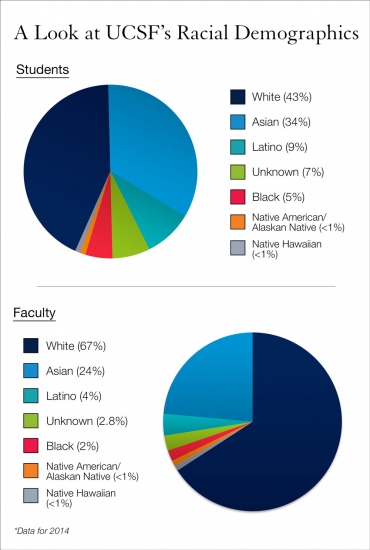Life After the ‘Die-In’
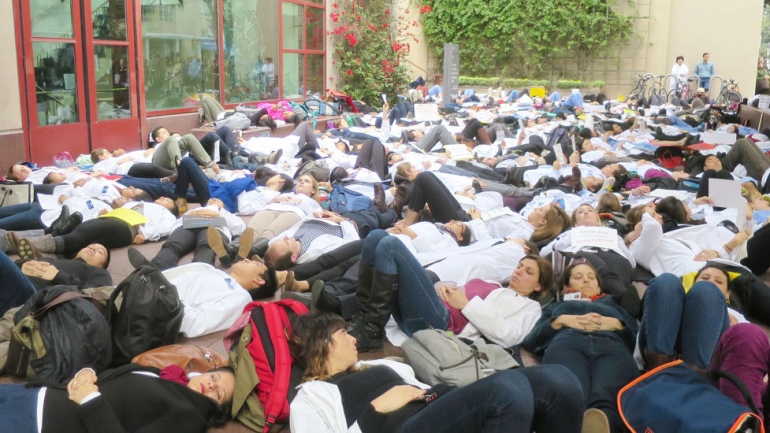
UC San Francisco medical students sparked a national movement in December when they launched #whitecoats4blacklives to bring attention to racial health care disparities.
Their act of courage inspired UCSF leaders to address racism head-on in its annual leadership retreat and has renewed a much-needed dialogue throughout campus.
A group of UCSF medical students gathered in a closed meeting last month to talk about race, racism and racial disparities.
They were troubled by recent grand jury decisions not to indict white police officers who were involved in the deaths of two unarmed African American men, Michael Brown in Ferguson, Mo., and Eric Garner in New York City, and wanted to channel their frustration into something constructive.

UCSF students participate in the Dec. 10 die-in protest. Photo by Leland Kim
The students, including many from the UCSF Underrepresented In Medicine (UIM) mentoring program, decided to hold a “die-in” at UCSF while wearing their white coats, symbolic of those in the health profession. They and their peers of all ethnic backgrounds tapped into student networks across the country.
In just five days, a national movement called #whitecoats4blacklives was born.
It catalyzed thousands of students, faculty and staff in more than 80 colleges across the country. At UCSF, students from all professional Schools (Dentistry, Medicine, Nursing and Pharmacy) and the Graduate Division participated, as well as some faculty and staff members.
The hashtag dominated social media on Dec. 10, garnering widespread media attention and sparking a much-needed national conversation about racism being more than a just criminal justice issue.
“As students, we were able to use the momentum from the #whitecoats4blacklives movement to demonstrate the urgency of dealing with the issues of race, micro-aggressions and inequality that affects UCSF faculty, staff, students, and most importantly the patients we all serve,” said student organizer Sidra Bonner, a second-year student in the School of Medicine. “It is my hope that this movement leads to improvement of the social medicine curriculum, specifically continued learning and skill development around this issue of bias, creation of a robust mentorship/advising system for all students, as well as commitment to strengthening the pipeline for underrepresented students in medicine by increased availability of scholarships and administrative support.”
A Priority for the University
The die-in had a ripple effect across UCSF.
A student-initiated town hall held two days after attracted faculty members, deans and many of the University’s top leaders, who talked openly with students about the UCSF’s ongoing challenge with diversity.
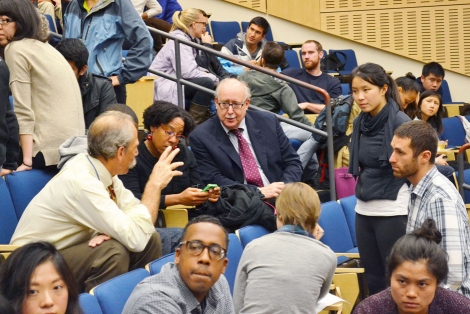
Students hosted a town hall event on Dec. 12 to open up a dialogue about race and racism. School of Pharmacy Dean B. Joseph Guglielmo (far left), School of Nursing's Monica McLemore (second from left), and School of Nursing Dean David Vlahov (center) were among the participants. Photo by Paul Day
Chancellor Sam Hawgood, MBBS, has made race and racial inequities a priority in his administration.
“This is an issue that goes beyond any one school or department; this is a campus issue,” he said. “Diversity is going to be an important priority for the entire UCSF community. I thank our students for initiating this conversation.”
And organizers of the School of Medicine’s annual leadership retreat this month decided to change the event’s agenda to discuss the enduring question of race in America – and how racial dynamics play out at UCSF.
“Our students are asking us to acknowledge, to think and to do something about the problem of racial and ethnic injustices,” said Bruce Wintroub, MD, interim dean of the School of Medicine, introducing a daylong colloquy that was rich in both data and personal stories about what it means to be black and brown in America.
“It is very easy to talk about racial disparities at other places,” he said. “It is much harder for us to take an honest look at the problems we have at UCSF.”
Groundbreaking Discussion of Race
The leadership retreat, which took place on Jan. 8 and 9, was the first one ever to focus solely on race/ethnicity and health disparities. It came as the School of Medicine has launched a six-year, $9.6 million effort to hold its departments accountable for achieving diversity, provide the resources to recruit and retain a more diverse faculty, create a culture of diversity and inclusion and expand the pool of scientific talent, which gets smaller at each level of training.
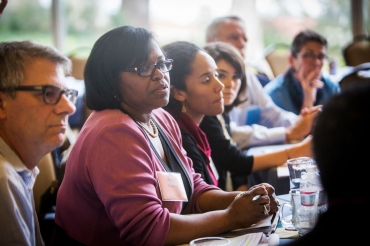
Renee Navarro, MD, PharmD, vice chancellor of Diversity and Outreach, listens to speakers during the 2015 School of Medicine leadership retreat, "Race Matters at UCSF." Photo by Elisabeth Fall
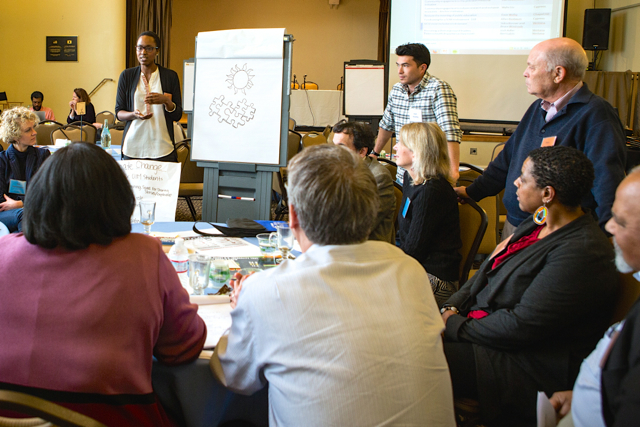
Medical student Sidra Bonner leads a discussion on race at the Jan. 9 retreat, as School of Medicine Dean Bruce Wintroub (far right, standing) and others listen. Photo by Elisabeth Fall
“This retreat was the first time in my 32 years at UCSF that I feel we have started to have an authentic conversation about race and the impact of racism and unconscious bias on our students, faculty and patients,” said Renee Navarro, MD, PharmD, vice chancellor of Diversity and Outreach. “I applaud the students who organized and implemented the #whitecoats4blacklives movement. They were the spark that led to this event.”
Some of those students were invited to participate in the leadership retreat and share their experiences with the group to help facilitate organizational change.
At times, nervous energy was palpable as students recalled instances of racism on campus. Some community members, participants noted, have accused UCSF being an “elitist ivory tower.”
White faculty members listened attentively, and some were candid enough to admit that they hadn’t really thought about racism and its impact on students and patients in a meaningful way.
“Being on the panel and speaking to an audience of accomplished and powerful people at UCSF were terrifying,” said Angela Broad, a second-year medical student. “It was really difficult sharing those experiences but the informal conversations I had throughout the day were very heartening. So many faculty, deans and staff thanked me for sharing my story.”
Compelling presentations and anecdotes by faculty of color helped shape the day’s conversation.
Guest speaker Denise Rodgers, MD, focused on the impact of race and racism on health and health care in her talk, helping the audience to understand how a climate of violence affects their patients and their health. Neil Powe, MD, MPH, MBA, vice chair of the Department of Medicine and chief of medical services at San Francisco General Hospital and Trauma Center, shared a story about being pulled over by the police in North Carolina while in town to give a lecture. A police officer suspiciously questioned Powe about his destination, instructed him to keep his hands on the steering wheel and asked him if he had drugs in the car.
“When we teach about homicide, do we reinforce the stereotype of violent, lawless black men who should be feared and for whom there is little hope for change?” asked Rodgers, vice chancellor of Rutgers Biomedical and Health Sciences. “When we teach about homicide, do we talk about poverty, unemployment, poorly-performing schools, inadequate access to social and mental health services as contributors to the homicide rates we see?”
Nurturing a Pipeline of UCSF Talent
This year, one-third of first-year medical students are underserved minorities (black, Latino, Native American or Pacific Islander), the highest percentage of any medical school in California.
Diversity in Education
Each of UCSF's four professional schools – dentistry, medicine, nursing and pharmacy – and the Graduate Division have diversity as a priority.
Learn more about what the schools are doing to improve access to education.
What Role Does Race Play in Research?
The retreat featured several faculty research presentations on how persisting in asking why some diseases or drugs affect people differently by race has lead to fundamental discoveries in disease mechanisms, as well as better clinical care.
Despite having one of the most diverse student populations in the nation, a recent survey found that nearly one-third of students who are black, Latino and Native American reported feeling shunned or ignored or having experienced behavior they found intimidating, offensive or hostile, and 21 percent said it interfered with their ability to learn. That was double the percentage reported by whites and a third higher than reported by Asians.
Talmadge King, MD, chair of the Department of Medicine, said the medical school is doing well at recruiting students, but many are not staying for their residency training.
Retention drops more at the fellowship training level and then essentially stops at the faculty level. Similar statistics also apply to the other professional schools and the Graduate Division.
King believes the best long-term strategy is for UCSF to build its own pipeline of talent, beginning with middle and high school, so students learn to love science and have an association to UCSF. “Places that have really focused on that are beginning to have success," he said. "It takes a long time, but it actually works.”
Turning Words into Action
UCSF leadership will review and evaluate ideas that were generated by the retreat participants and determine the priorities and tactics to move them forward. This effort is aligned with the campus obligation to the University of California Office of the President to identify initiatives in the UC-wide Climate Survey. Those initiatives will include one that is focused on establishing a “climate of inclusion.”
Meanwhile, the students who organized the #whitecoats4blacklives event have formalized the creation of the national White Coats for Black Lives organization that was born out of the movement. They are connected with 83 representatives of various medical schools throughout the country and are in the process of creating a national board for their student organization.
They will also be actively involved in working with faculty and leadership to achieve the goals identified during the leadership retreat.
“I have never felt so inspired by UCSF – what it is and what it can be,” said student organizer Nicolás Barceló, a fourth-year medical student who attended the retreat. “My decision to attend UCSF was motivated by the belief that its capacity to effectively address the social determinants of health, it stands alone. No other institution can bring together the resources, talent and dedication to social justice that you see at UCSF. No one.”
For more internal-facing stories from the UCSF community, please visit Pulse of UCSF.
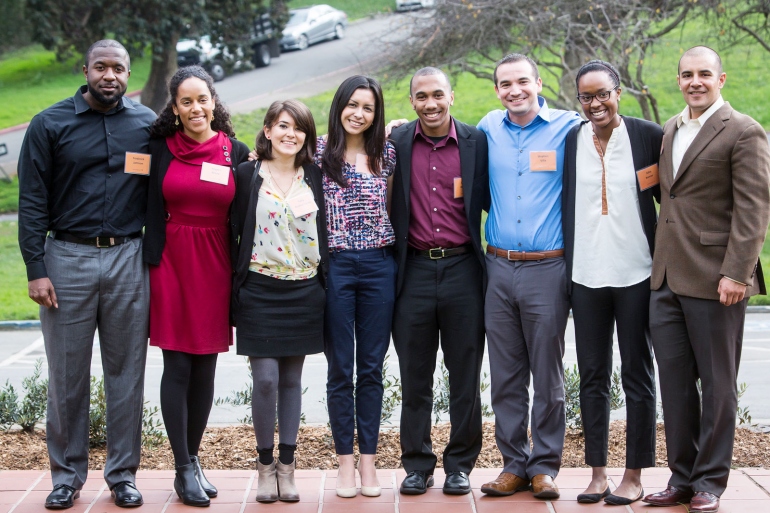
Organizers of the student #whitecoats4blacklives die-in were invited to participate in the School of Medicine leadership retreat to share their experiences. From left, Frederick Jamison, Angela Broad, Faby Molina, Adali Martinez, Donald Richards, Stephen Villa, Sidra Bonner, and Nicolás Barceló. Photo by Elisabeth Fall
Related Links
- Official Website for the National #WhiteCoats4BlackLives Movement
- UCSF Students Lead National Movement Bringing Attention to Impact of Racial Disparities in Health Care
- UCSF Commends Student Leaders for Organizing Peaceful Demonstration, Reinforces Commitment to Diversity
- #WhiteCoats4BlackLives Speech (Synapse Student Newspaper)
- Race Matters - Turning Conversations Into Actions
